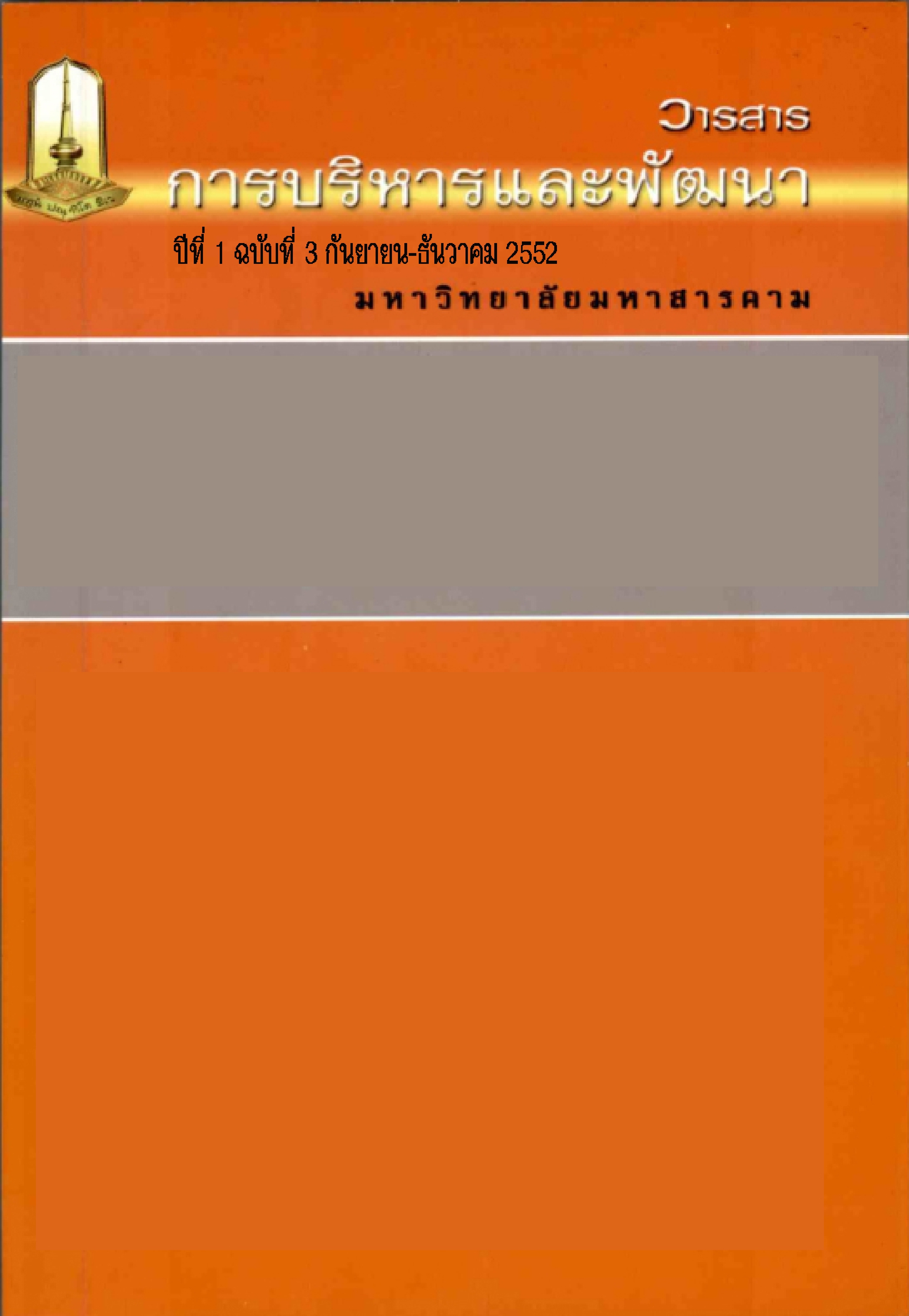Guidance Based on National Emotive Theory for Decreasing Anxiety about Entrance Examinations for Higher Educational Institutions in the Central System
Main Article Content
Abstract
The purposes of this study were : 1) to examine anxieties about highereducational institution entrance examinations in the central system of students using the (1) teaching method according to the guidance program based on national emotive theory, and those using teaching method according to the plans for organization of activities in the guidance periods. 2) to compare anxieties about higher educational institution entrance examinations in the central system of students between before experiment and after the experiment by using the (1) teaching method according to the guidance program based on the
national emotive theory, and the (2) teaching method according to the plans for organization of activities in the guidance periods, and 3) to compare anxieties about higher educational institution entrance examinations in the central system of students between the students treated by teaching method according to the guidance program based on the national emotive theory and those treated by the (2) teaching method according to the plans for organization of activities in the guidance periods. The sample consisted of 40 students obtained from Suwanaphuma Wittayalai School through the purposive sampling technique. They were classified into experimental group 1 with 20 students treated by the teaching method according to guidance program based on the national emotive theory, and experiment group 2 with 20 students treated by the teaching method according to the plans for organization of activities in the guidance periods. The instruments used in the study were a guidance activities program based on the national emotive theory, and the plans for organization of activities is the guidance periods as well as a scale on anxiety about higher educational institution entrance examinations in the central system. The collected data were analyzed by mean, standard deviation, t-test (dependent samples), and t-test (independent samples).
The results of the study were as follows:1. The experiment through the teaching method according to the guidance program base on the national emotive theory , the students had anxieties about higher educational institution entrance examinations in the central system before experiment as a whole and in each of the 29 items at a high level and 1 item at a medium level. The item with the highest mean was Item 28 : I feel myself that I don’t know which faculty or which educational institution I would rather apply for study. After the treatment, their anxieties as a whole and in each of the 21 items were at a medium level, and 9 items at a low level. The item with the highest mean was Item 29 : I feel that I haven’t known any trick for entrance examinations, and the students treated by teaching method according to the plans for organization of activities in the guidance periods they had anxieties about higher educational institution entrance examinations in the central system before and after experiment as a whole and in each of all the items at a high level. The item at the highest mean was Item 28: I feel myself that I don’t know which faculty or which educational institution I would rather apply for study.
2. The experiment through the teaching method according to the guidance program based on the national emotive theory, the students had anxieties about higher educational institution entrance examinations in the central system between before and after the experiment different at the .05 level of statistical significance, and the experiment to using the (2) teaching method according to the plans for organization of activities in the guidance periods, the students had anxieties about higher educational institution entrance examinations in the central system between before and after experiment don’t to difference.
3. The students through the teaching method according to the guidance program based on national emotive theory have anxieties about higher educational institution entrance examinations in the central system lower than those through the (2) teaching method according to the guidance periods at the .05 level of statistical significance.
Downloads
Article Details
References
กรมสามัญศึกษา กระทรวงศึกษาธิการ. (2541). แผนการจัดกิจกรรมในคาบแนะแนวของศูนย์พัฒนาคุณภาพงานแนะแนว. กรุงเทพฯ : โรงพิมพ์คุรุสภาลาดพร้าว.
กุงศรี จุลนะมานี. (2545). ผลของการใช้โปรแกรมแนะแนวอาชีพที่มีต่อการคัดเลือกอาชีพของนักเรียน ชั้นมัธยมศึกษาปีที่ 6 โรงเรียนมัธยมสมบูรณ์สาธิตมหาวิทยาลัยแห่งชาติลาว. วิทยานิพนธ์ กศ.ม. ชลบุรี : มหาวิทยาลัยบูรพา.
ฉวีวรรณ ใหม่คำมิ. (2541). ความวิตกกังวลในการสอบคัดเลือกเข้าศึกษาต่อระดับอุดมศึกษาชั้นมัธยมศึกษาปีที่ 6 โรงเรียนสังกัดกรมสามัญศึกษา เขตอำเภอเมืองจังหวัดมหาสารคาม. วิทยานิพนธ์ กศ.ม. มหาสารคาม : มหาวิทยาลัยมหาสารคาม.
ไทยรัฐ. (16 พฤษภาคม 2551). นักเรียน ม.6 ระเบิดขมับดับอนาคต เหตุเครียดจัดสอบแอดมิสชั่นไม่ติด. ไทยรัฐ, หน้า 22.
ธันย์ วรรณโชดก. (2536). การเปรียบเทียบผลสัมฤทธิ์ทางการเรียนและการปรับตัวของนิสิตปีที่ 1 มหาวิทยาลัยนเรศวรที่เข้าเรียนด้วยการสอบคัดเลือกจากทบวงมหาวิทยาลัย และสอบคัดเลือกจากระบบโควตา ปีการศึกษา 2535. วิทยานิพนธ์กศ.ม. พิษณุโลก : มหาวิทยาลัยนเรศวร.
เผด็จ ภู่ประจำ ศิลป์. (2545). การจัดบริการแนะแนวในโรงเรียนขยายโอกาสทางการศึกษา สังกัดสำนักงานการประถมศึกษา. วิทยานิพนธ์ วท.ม. ชลบุรี :มหาวิทยาลัยบูรพา.
พนม ลิ้มอารีย์. (2533). การแนะแนวเบื้องต้น. กรุงเทพฯ : โอเดียนสโตร์.
รัศมี เพชรมีศรี. (2546). ผลการให้คำปรึกษาแบบกลุ่มตามทฤษฏีเหตุผลและอารมณ์ที่มีต่อ การพัฒนาความเชื่อมั่นในตนเองและลดความเครียดของนักเรียนแผนกธุรกิจพยาบาล โรงเรียนเทคโนโลยีชนะพลขันธ์ นครราชสีมา ปีการศึกษา2546. การศึกษาค้นคว้าอิสระ กศ.ม. มหาสารคาม : มหาวิทยาลัยมหาสารคาม.
ศิริศักดิ์ แสงอาษามาศ. (2548). ความวิตกกังวลที่มีต่อการสอบคัดเลือกบุคคลเข้าศึกษาต่อในสถาบันอุดมศึกษาระบบใหม่ของนักเรียนในเขตอำเภอเมือง จังหวัดเชียงใหม่. การศึกษาค้นคว้าอิสระ กศ.ม. เชียงใหม่ : มหาวิทยาลัยเชียงใหม่.
อาภา จันทรสกุล. (2536). ทฤษฏีและการให้คำปรึกษา. กรุงเทพฯ : ภาคจิตวิทยาการศึกษาและการแนะแนว มหาวิทยาลัยเกษตรศาสตร์.
Eills, A and, J.M Whiteley. (1997). The Therretical and Empirical Foundation of Ration-Emotion Therapy. Pacific Grove : Brooks Cole Publishing.


